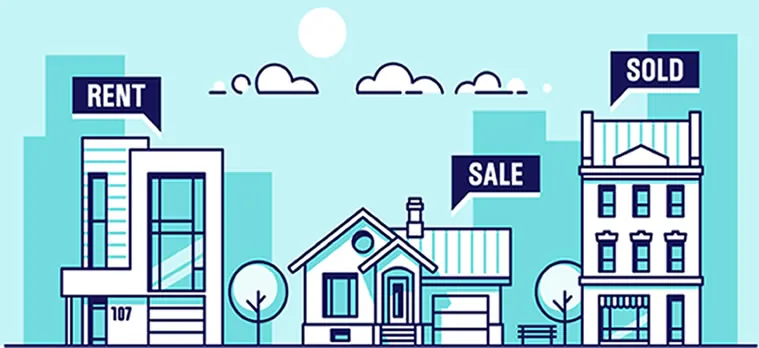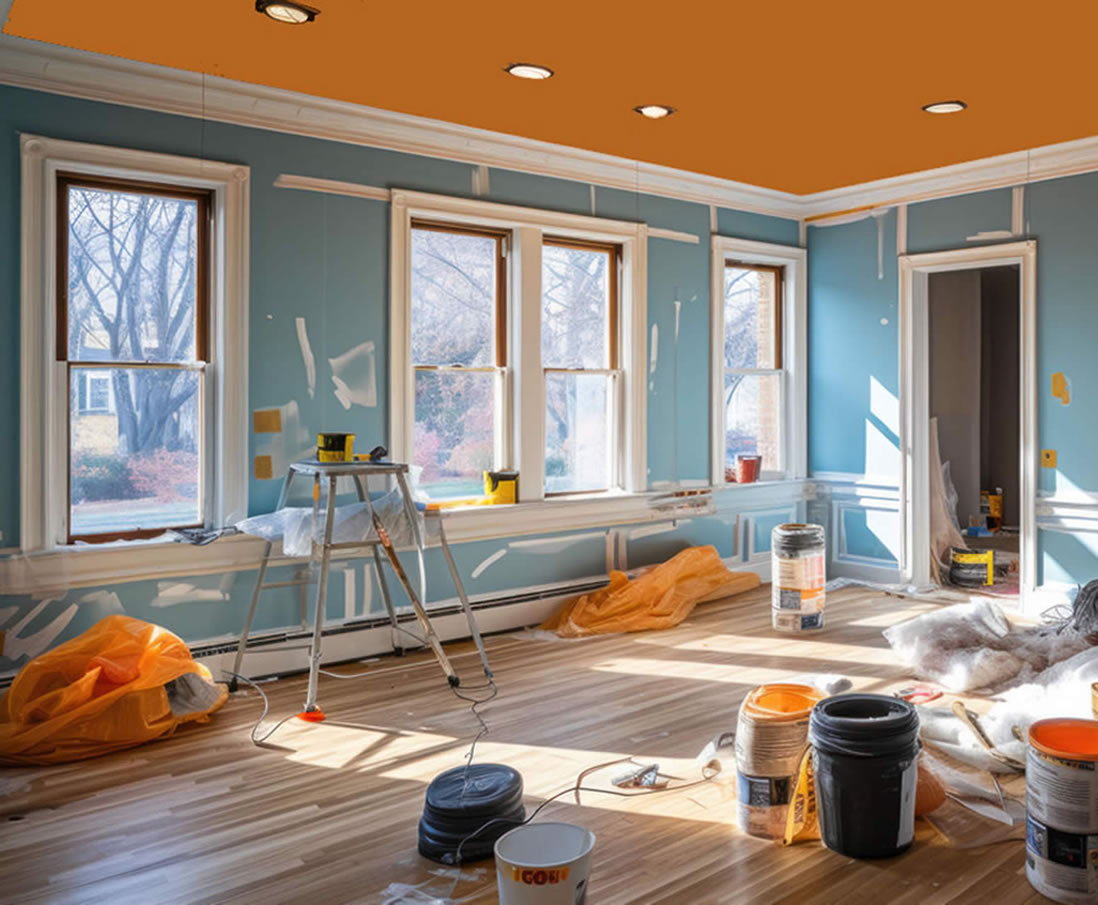Buy Refurbish Refinance Rent: Building a Rental Portfolio Quickly
If you're building a buy-to-let property portfolio, the buy refurbish refinance rent strategy should be considered.
It's a proven method that allows property investors to maximise the efficiency of their initial capital. By recycling funds through refinancing, this strategy can help grow your property quickly.
Request a Callback.
WHAT IS BUY REFURBISH REFINANCE RENT
Buy refurbish refinance rent also known as BRRR is a popular property investment strategy that is used by experienced investors, landlords and developers. It's a cyclical process allowing you to plan and recycle your deposit money by using the same money for further property purchases to build a portfolio of rental properties.
Here, we explain what BRRR is, how it works, and what the benefits and challenges of using it are.
Table of Contents
- What Is Buy Refurbish Refinance Rent
- FAQs About the BRRR Strategy
- The 4 Steps of Buy Refurbish Refinance Rent
- Case Studies: For the BRRR Strategy
- BRRR in 2025: What's Changing and What's Next
- What Are the Benefits of the BRR Strategy?
- What Are the Challenges of the BRR Strategy?
- How to Apply: A Step-by-Step Guide

FAQ'S ABOUT THE BRRR STRATEGY
💬 What is the BRRR Strategy?
🧠 Broker Tip: Timing is everything, the key to a successful BRRR project is ensuring your bridging loan, refurb works, and remortgage application are all planned in advance. Aim to start refinance prep before works complete to minimise capital lock-up.
💬 What are the benefits of using the BRRR strategy?
🧠 Broker Tip: Recycling funds sounds simple, but the real benefit comes when the uplift in value is enough to release most or all of your original input. Focus on deals with strong comparables and realistic post-refurb valuations to maximise ROI.
💬 Is BRRR suitable for all types of properties?
🧠 Broker Tip: Lender appetite varies by property type. While residential buy-to-lets are widely accepted, commercial or mixed-use BRRR deals may require specialist lending — and may come with lower LTVs or tighter exit options.
💬 What refinance LTV can I expect in 2025?
🧠 Broker Tip: To avoid valuation issues, aim for your OMV to be at least 25% higher than total costs.
💬 How long do lenders require ownership before refinance?
🧠 Broker Tip: If refinancing speed is crucial, a broker familiar with these fast-track options can help avoid costly delays.
💬 What if refurb costs overrun — what are fallback options?
🧠 Broker Tip: Always flag potential overruns early, bridging lenders prefer proactive updates to reactive requests.
💬 How can I get started and fund a BRRR project?
🧠 Broker Tip: The fastest route to success is working with a broker who can source both your bridging and exit finance. By planning your remortgage lender in advance, you avoid delays and reduce the risk of being stuck on expensive short-term funding.
THE 4 STEPS OF BUY REFURBISH REFINANCE RENT
STEP 1: BUYING THE PROPERTY
The first step is to find a property that fits the BRRR method, it could be below market value, in a location with good rental demand, and in need of refurbishment.
To fund the property purchase, you can arrange a short-term bridging loan through a commercial broker, you'll need money for the deposit, although below market value bridging finance is sometimes possible if the purchase price is below the market value, meaning a lower deposit.
A traditional mortgage wouldn't be suitable for uninhabitable properties or if the property is for sale at auction, as the required timescales are too short for a traditional mortgage lender to complete.
When implementing the strategy, you should inspect the property and get a surveyor to assess its condition, provide a current valuation, an after renovation valuation and the potential rental value. You should negotiate the best possible price and terms with the seller, and aim to complete as quickly as possible.
When buying below market value, always request a dual-valuation report — one showing the current value and one showing the post-refurbishment value (often called a “GDV” – Gross Development Value). This strengthens your case for enhanced bridging terms and may help reduce your deposit if the lender is willing to lend against the open market value rather than the purchase price.
STEP 2: CARRYING OUT THE REFURBISHMENT
The second step is the refurbishment stage. This could involve cosmetic changes, such as painting, flooring, and decorating, or more costly works, such as installing a new kitchen, bathroom, or heating system. The extent and cost will depend on the condition and size of the property, and your budget and goals.
The aim is to make it more attractive and functional for renters and buyers, and to increase its value through refurbishment. You should plan the refurbishment phase carefully and hire reliable and qualified contractors to do the work, and ensure it complies with the building regulations.
Before starting works, check whether your lender requires a “light” or “heavy” refurbishment product. This affects not only your interest rate and exit options but also the lender’s attitude toward structural work, permitted trades, and staged drawdowns. Always notify your broker of any change in the refurbishment scope — it can impact your funding conditions or trigger early repayment penalties if not handled correctly.
STEP 3: REFINANCING THE PROPERTY
The third step, after completion of the renovation is to implement the exit strategy by completing the switch to a BTL mortgage based on the new higher valuation. This is where you repay the initial loan and recover your financial input to re-use in the next buy refurbish refinance deal. The goal of the remortgage is to repay the short-term purchase facility, recover your initial deposit money and refurbishment costs, have a positive cash flow and create and leave equity within the property.
To remortgage, you would contact your experienced commercial finance broker to begin the process of instructing the type of valuation required based on the new higher valuation when applying for a buy to let mortgage.
The amount of money you can refinance and cash out will depend on the new mortgage value of the property, the loan-to-value ratio, and the interest rate. The LTV ratio is the percentage that the Buy to let mortgage lender is willing to lend.
To maximise your refinance outcome, instruct the valuation at the right time — ideally after the works are 100% complete, the property is clean and staged, and all compliance certificates are available. An experienced broker will time this for you and may suggest a lender that accepts desktop or AVM valuations for speed if the property is tenanted and ready for remortgage.
STEP 4: FINDING A SUITABLE TENANT
The final step in completing the strategy is to rent out the property and collect the income. This is where you can enjoy the passive income and the capital appreciation of your asset. You will need to find and screen tenants, prepare the tenancy agreement, and manage the property. You can do this yourself, or hire a letting agent. A letting agent will help you with the marketing, administration, and maintenance, and also help you comply with landlord responsibilities.
If your refinance lender requires an AST (Assured Shorthold Tenancy) in place before completion, work with your broker and letting agent to coordinate tenant move-in dates with the remortgage timeline. Some lenders will accept a signed tenancy agreement pre-completion, while others need the tenant to be physically in place — this can be critical for fast cash release.
CASE STUDIES: FOR THE BRRR STRATEGY
2 Bedroom Flat Glasgow
Buy: The developers used the BRRR method when purchasing a run-down 2-bedroom flat in Glasgow for £70,000 at auction, significantly below the market value. The property was not suitable for a traditional mortgage due to its poor condition, so a short-term bridging facility was used to help with the purchase.
Refurbish: They spent £20,000 on upgrading, Installing a new kitchen and bathroom, repainting and re-carpeting the entire flat, including damp proofing. Total Investment: £90,000 (£70,000 purchase + £20,000 refurb).
Refinance: After upgrading, the flat was revalued at £130,000 and refinanced with a BTL mortgage at 75% LTV, releasing £97,500. This covered their initial costs.
Rent: The flat was rented for £850/pcm, resulting in a monthly profit of £270 after accounting for the mortgage and other expenses.
Outcome: The developers successfully recycled their capital to start another project, while generating positive cash flow and benefiting from long-term asset appreciation.
3 Bedroom Terraced House Manchester.
Buy: The investor bought a tired 3-bedroom terraced house in Manchester for £75,000 via a local estate agent. The property required significant upgrading but was structurally sound, making it a good BRRR deal. A bridging loan was used to help with the purchase.
Refurbish: He allocated £30,000 to renovations, installing a modern kitchen and bathroom, upgrading the central heating system, redecorating and adding new flooring. Total Investment: £105,000 (£75,000 purchase + £30,000 refurb).
Refinance: After completion, the property was revalued at £150,000 and remortgaged at 75% LTV, withdrawing £112,500. This covered the purchase and refurb costs.
Rent: The house was leased to a family for £975/pcm, generating a profit of £300/month from the rental income after deducting all expenses.
Outcome: The initial deposit money was recovered, enabling the investor to replicate the strategy with another property while securing a steady rental income.
BRRR IN 2025: WHAT'S CHANGING AND WHAT'S NEXT
The BRRR strategy continues to be a valuable tool for property investors in 2025 — but its success now depends on smarter execution and sharper financial planning. In a more cautious lending environment, the days of easy capital recycling are over, but strong deals still exist for investors who understand the evolving landscape.
Lending Environment
• Base Rates: The Bank of England base rate remains at 4.75%, with lenders pricing BRRR refinancing options more conservatively than during the low-rate era.
• Loan-to-Value (LTV): Many lenders now require at least 25% equity post-refurb for a successful remortgage — and will often use bricks-and-mortar valuations, not end-use or yield-based figures.
• Minimum Ownership Periods: Some lenders still enforce 6-month title seasoning, although bridge-to-let and day-one remortgage options are available through specialist brokers.
Cost Pressures
• Refurbishment Costs: Material and labour inflation has moderated but remains high in urban centres. Investors should budget for £80–£120 per sq. ft. for moderate refurbishments.
• Valuation Caution: Surveyors in 2025 are under stricter guidance to evidence comparables. Investors should allow a 10% valuation buffer to avoid refinancing shortfalls.
Regional BRRR Hotspots (2025)
• Scotland: Cities like Glasgow and Dundee remain attractive due to competitive property prices and steady rental demand.
• North East England: Areas like Sunderland and Middlesbrough offer strong rental yields and low entry points.
• Postcode-level insight matters: In 2025, BRRR is hyper-local. One street can be profitable while the next struggles with demand or low valuation confidence.
Tenant Demand & Regulation
• Energy Performance (EPC): Properties with a C rating or above are increasingly favoured by lenders and tenants alike. Investors should consider EPC upgrades during refurb.
• Rental Demand: Urban areas with strong transport links and remote-working-friendly homes (e.g. 2 beds with office space) are outperforming.
• Stronger due diligence is critical: You need to buy right, refurb right, and finance smart.
• Time and cost buffers are essential: Delays or value shortfalls can erode ROI quickly.
• Professional advice gives the edge: A broker who understands BRRR intricacies can unlock products (like day-one remortgage) that save months and thousands in bridging costs.
BRRR isn’t dead, it’s just become more professional. The investors who treat it like a business, not a side hustle, are the ones still succeeding.
WHAT ARE THE BENEFITS OF THE BRR STRATEGY?
• You can buy more properties with less money, by recycling your money and using leverage.
• You can increase the value of your properties, by improving through renovation.
• You can generate passive income and capital appreciation from your properties and benefiting from the market growth.
• You can diversify your portfolio and reduce your risk, by investing in different locations.
• You can scale up your business and achieve your financial goals faster, by repeating the process and buying more properties.
WHAT ARE THE CHALLENGES OF THE BRR STRATEGY?
• You need to have some cash and access to funding, to buy and upgrade the properties.
• You need to have the skills and knowledge, to find, analyse, and manage the projects.
• You need to have the time and patience, to complete the upgrading and the refinancing.
• You need to have a contingency plan and a buffer, to manage any unexpected costs, delays, or problems.
HOW TO APPLY: A STEP-BY-STEP-GUIDE
Consult with an Expert Broker:
We can guide you through the intricacies of the process, help you explore available lender options, and provide personalised guidance.
Who Is It For?
• First time buyers, experienced Developers and Landlords.
Application Process:
• Speak to a BRRR finance expert.
• Provide Documentation.
• Financial projections.
Receive Your Offer:
If your project aligns with the criteria, you’ll receive initial terms within 24 hours. The strategy has a lot of moving parts, preparation and professional guidance are essential for a successful application.
The buy refurbish refinance rent technique is a powerful and proven method of investing in property and building your portfolio. It involves buying, renovating, refinancing, and renting properties, and repeating the process. It allows you to recycle your money, add value to your assets, generate passive income, and achieve your financial goals.
WE SPECIALISE IN

Buy refurbish refinance rent.
The BRRR strategy is a popular investment technique commonly used by experienced landlords, investors and property developers to maxmise their return on investment.
It works by purchasing properties that can be improved through refurbishment, raising their value and rental potential.
Once renovated, the property can be refinanced at its higher market value, allowing investors to release capital for the next purchase.
Our BRRR Experience.

BMV Bridging Loans
Traditionally the lower of the price being paid for a property or the open market value of the property is used for calculating the LTV and maximum borrowing available.
When buying a property at a discount to it's Open Market Value, below market value bridging loans use the OMV for the LTV calculation instead of the purchase price, allowing property investors to borrow more with a smaller deposit.
Our BMV Bridging Loan Experience.

Company BTL Mortgages
A limited company buy-to-let mortgage is a specialist type of mortgage for landlords who would like to buy property or refinance existing properties through a limited company.
Some of the primary benefits include the ability to claim 100% mortgage interest relief and lower Corporation Tax on profits.
Our Buy to Let Mortgage Experience.
3 reasons to choose us as your SOURCE FOR PROPERTY FINANCE.
Highly Experienced
We have over 30 years experience and can offer innovative financing methods for developers and investors.


Services
We offer Bridging finance, Refurb & New Build Development Finance and Buy to Let Mortgages.

Quality Support
We'll keep you informed every step of the way and if required, continue to support even after completion.


download our free property profit calculator

We built the Property Profit Calculator App as an aid for Property Developers & Landlords.
We wanted to build an app that had a real convenience and benefit to others in our property and finance world.
The App is Forever Free to use with or without a borrowing requirement.
Easily assess the viability of your property project within 60 seconds, then if required, book a time slot to discuss your project with an expert.
what our clients think about us - matters
Delighted with the excellent service and attention to detail! I was always kept informed about my residential development bridging finance application. Plus, I saved over £1,000 in legal fees, and the process was completed ahead of schedule! Happy Days.
Mr. C from Glasgow. Property Developer / Landlord.
JUST SOME OF THE LENDERS WE WORK WITH











